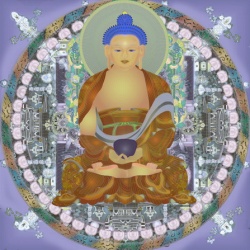Difference between revisions of "Inclusion of the nine worlds in Buddhahood"
| Line 1: | Line 1: | ||
[[File:AmithapaV copy.jpg|thumb|250px|]] | [[File:AmithapaV copy.jpg|thumb|250px|]] | ||
| + | |||
| + | |||
| + | |||
| + | |||
| + | |||
| + | |||
| + | |||
| + | |||
| + | |||
| + | |||
| + | |||
| + | |||
<poem> | <poem> | ||
[[inclusion of the nine worlds in Buddhahood]] | [[inclusion of the nine worlds in Buddhahood]] | ||
| Line 6: | Line 18: | ||
The [[principle]] that the nine [[worlds]] are [[inherent]] in [[Buddhahood]]. That is, the [[world]] of [[Buddhahood]] possesses the [[nine worlds]], i.e., the [[world of hell]], the [[world of hungry spirits]], the [[world of animals]], the [[world of asuras]], the [[world of human beings]], the [[world of heavenly beings]], the [[world of voice-hearers]], the [[world of cause-awakened ones]], and the [[world of bodhisattvas]]. The [[nine worlds]] indicate [[realms]] or states of [[life]] that are [[tainted]] by [[illusions]] and [[suffering]]. According to this [[principle]], a [[Buddha]] does not eradicate the [[nine worlds]] even after [[attaining]] [[enlightenment]], but retains and uses them to save the [[people]]. | The [[principle]] that the nine [[worlds]] are [[inherent]] in [[Buddhahood]]. That is, the [[world]] of [[Buddhahood]] possesses the [[nine worlds]], i.e., the [[world of hell]], the [[world of hungry spirits]], the [[world of animals]], the [[world of asuras]], the [[world of human beings]], the [[world of heavenly beings]], the [[world of voice-hearers]], the [[world of cause-awakened ones]], and the [[world of bodhisattvas]]. The [[nine worlds]] indicate [[realms]] or states of [[life]] that are [[tainted]] by [[illusions]] and [[suffering]]. According to this [[principle]], a [[Buddha]] does not eradicate the [[nine worlds]] even after [[attaining]] [[enlightenment]], but retains and uses them to save the [[people]]. | ||
| − | In other words, even when one has attained [[Buddhahood]], the [[nine worlds]] continue to [[exist]] in one's [[life]], as does the potential for [[suffering]] and [[illusions]]. This [[principle]] is derived from the [[Lotus Sutra]], particularly the "[[Life]] Span" (sixteenth) chapter, and with the [[inclusion of Buddhahood in the nine worlds]] explains [[T'ient'ai's]] {{Wiki|concept}} of the mutual possession of the [[Ten Worlds]]. The "[[Life]] Span" chapter reads: "The [[scriptures]] expounded by the [[Thus Come One]] are all for the purpose of saving and emancipating [[living beings]]. Sometimes I speak of myself, sometimes of others; sometimes I {{Wiki|present}} myself, sometimes others; sometimes I show my own [[actions]], sometimes those of others. All that I {{Wiki|preach}} is true and not false." [[T'ient'ai]] (538-597) interprets "myself" in the quotation as the [[Buddha's]] [[Dharma body]] and "others" as his [[manifested body]]. He says that, when the [[Buddha]] teaches directly from the standpoint of his [[enlightenment]], he speaks of "myself" ([[Buddhahood]]), and when he teaches in accord with the people's capacity, he speaks of "others" (the nine [[worlds]]). | + | In other words, even when one has [[attained]] [[Buddhahood]], the [[nine worlds]] continue to [[exist]] in one's [[life]], as does the potential for [[suffering]] and [[illusions]]. This [[principle]] is derived from the [[Lotus Sutra]], particularly the "[[Life]] Span" (sixteenth) [[chapter]], and with the [[inclusion of Buddhahood in the nine worlds]] explains [[T'ient'ai's]] {{Wiki|concept}} of the mutual possession of the [[Ten Worlds]]. The "[[Life]] Span" [[chapter]] reads: "The [[scriptures]] expounded by the [[Thus Come One]] are all for the {{Wiki|purpose}} of saving and emancipating [[living beings]]. Sometimes I speak of myself, sometimes of others; sometimes I {{Wiki|present}} myself, sometimes others; sometimes I show my [[own]] [[actions]], sometimes those of others. All that I {{Wiki|preach}} is true and not false." [[T'ient'ai]] (538-597) interprets "myself" in the quotation as the [[Buddha's]] [[Dharma body]] and "others" as his [[manifested body]]. He says that, when the [[Buddha]] teaches directly from the standpoint of his [[enlightenment]], he speaks of "myself" ([[Buddhahood]]), and when he teaches in accord with the people's capacity, he speaks of "others" (the nine [[worlds]]). |
</poem> | </poem> | ||
{{R}} | {{R}} | ||
[http://www.sgilibrary.org/search_dict.php?SearchSelect=dict&p=2&m=1&in=2&q=hell www.sgilibrary.org] | [http://www.sgilibrary.org/search_dict.php?SearchSelect=dict&p=2&m=1&in=2&q=hell www.sgilibrary.org] | ||
[[Category:Six Realms]] | [[Category:Six Realms]] | ||
Latest revision as of 05:22, 2 April 2024
inclusion of the nine worlds in Buddhahood
仏界即九界・仏界所具の九界 (Jpn bukkai-soku-kukai or bukkai-shogu-no-kukai )
The principle that the nine worlds are inherent in Buddhahood. That is, the world of Buddhahood possesses the nine worlds, i.e., the world of hell, the world of hungry spirits, the world of animals, the world of asuras, the world of human beings, the world of heavenly beings, the world of voice-hearers, the world of cause-awakened ones, and the world of bodhisattvas. The nine worlds indicate realms or states of life that are tainted by illusions and suffering. According to this principle, a Buddha does not eradicate the nine worlds even after attaining enlightenment, but retains and uses them to save the people.
In other words, even when one has attained Buddhahood, the nine worlds continue to exist in one's life, as does the potential for suffering and illusions. This principle is derived from the Lotus Sutra, particularly the "Life Span" (sixteenth) chapter, and with the inclusion of Buddhahood in the nine worlds explains T'ient'ai's concept of the mutual possession of the Ten Worlds. The "Life Span" chapter reads: "The scriptures expounded by the Thus Come One are all for the purpose of saving and emancipating living beings. Sometimes I speak of myself, sometimes of others; sometimes I present myself, sometimes others; sometimes I show my own actions, sometimes those of others. All that I preach is true and not false." T'ient'ai (538-597) interprets "myself" in the quotation as the Buddha's Dharma body and "others" as his manifested body. He says that, when the Buddha teaches directly from the standpoint of his enlightenment, he speaks of "myself" (Buddhahood), and when he teaches in accord with the people's capacity, he speaks of "others" (the nine worlds).
